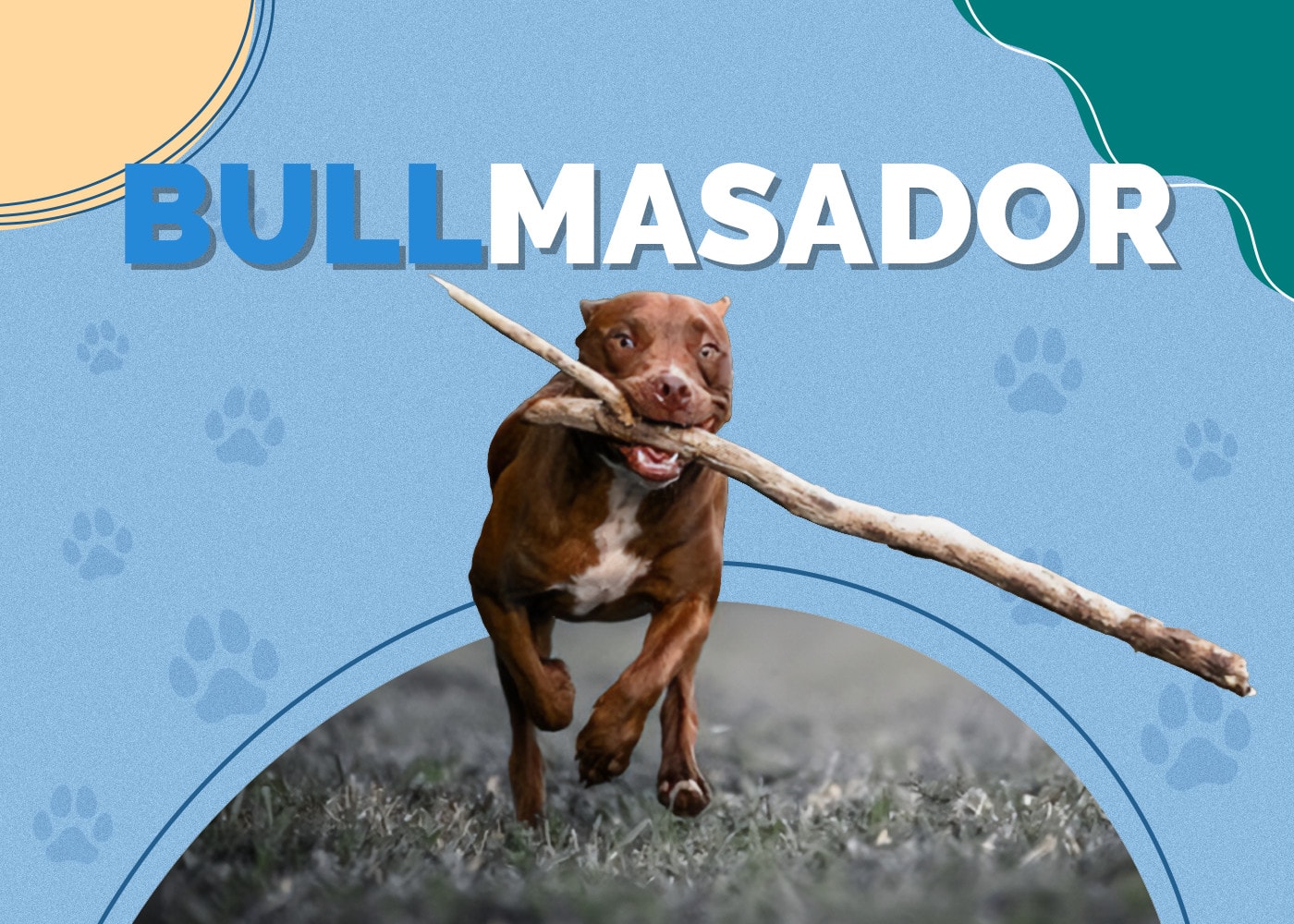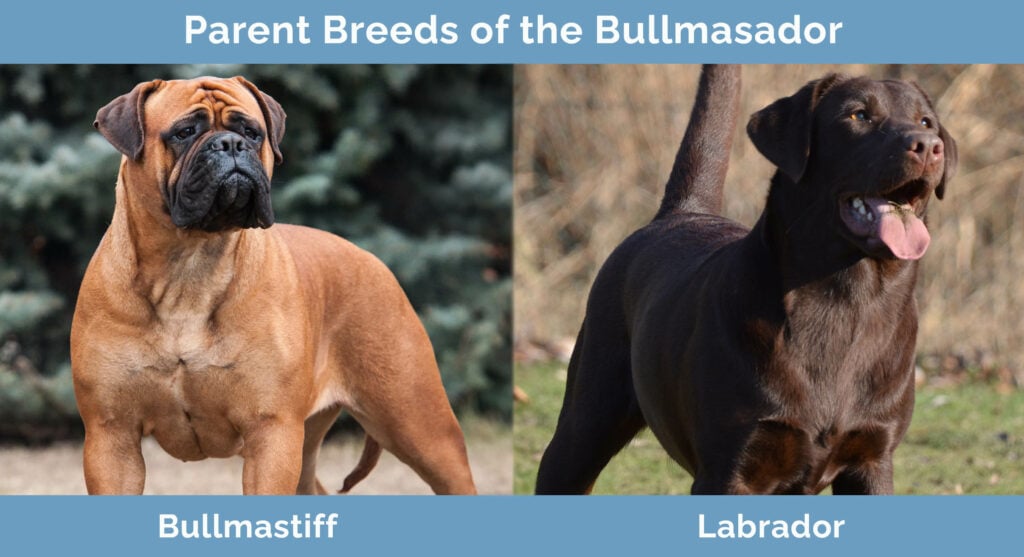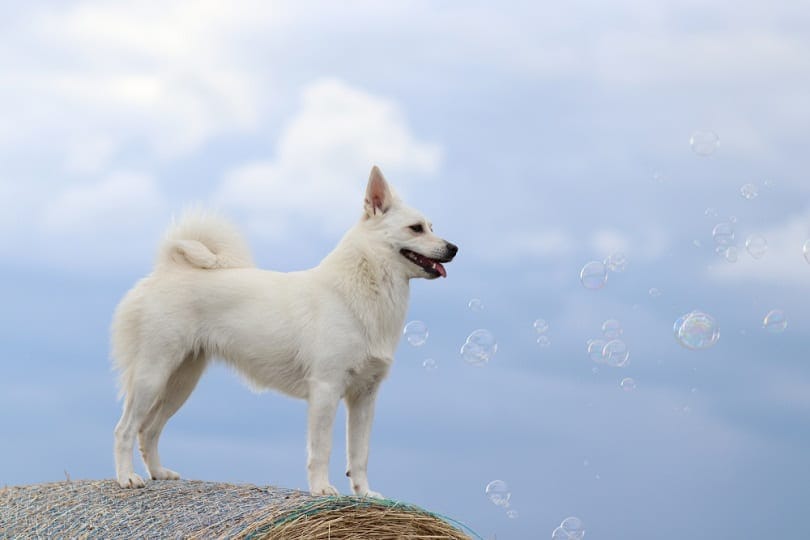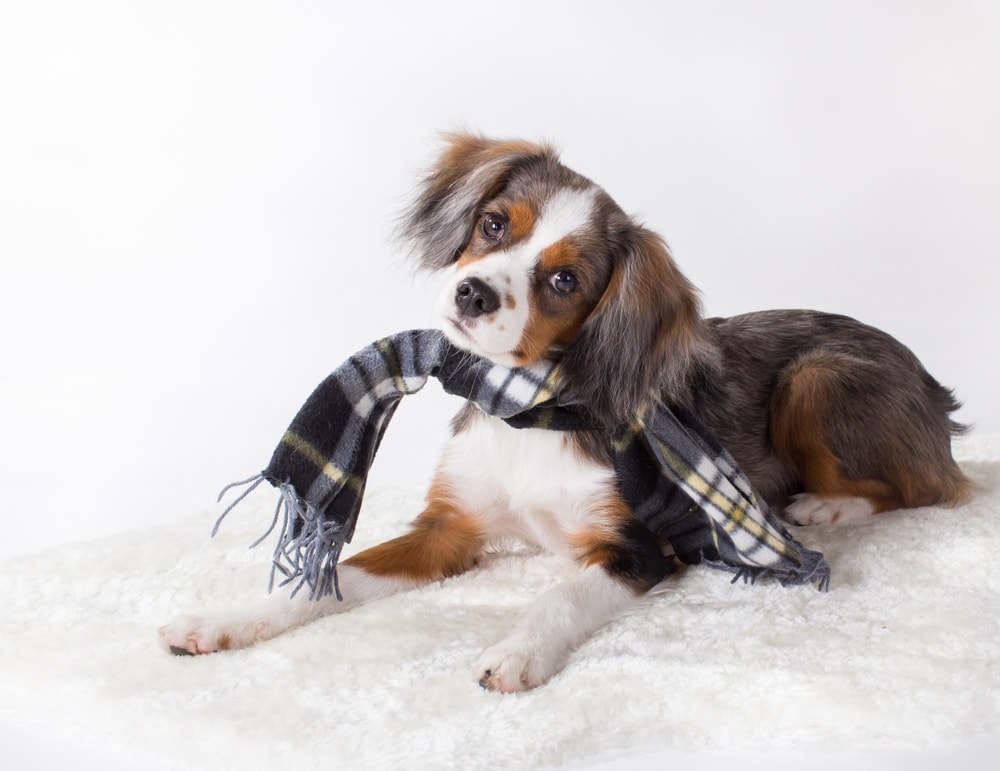Mastiff Lab Mix (Bullmasador) | Dog Breed Info & Pictures

Updated on

| Height: | 23 – 29 inches |
| Weight: | 70 – 180 pounds |
| Lifespan: | 10 – 12 years |
| Colors: | Brown, black, tan, red, chocolate, fawn, brindle |
| Suitable for: | Individuals and families with previous dog experience and a large yard |
| Temperament: | Loyal, calm, protective, watchful, gentle, energetic |
Gentle with children and naturally watchful, the Bullmasador is a versatile canine that makes a great watchdog or a loving and loyal companion. But these are giant dogs that can weigh as much as 180 pounds, so owning one is not to be taken lightly. Even though they’re very smart and quite trainable compared to other breeds, they can still be difficult for a first-time owner due to their gigantic size.
Though they’re well-suited for families and individuals alike, their size means they won’t do well in a small space like an apartment. And since they have pretty hefty exercise requirements, a sizable yard where they can run around and expend their excess energy is a necessity.
You won’t find the Bullmasador on any AKC list though because this is a designer breed, which means that they’re a deliberate cross between two pure breeds of dogs. In the case of the Bullmasador, the parents are a Bullmastiff and a Labrador Retriever.
Despite their massive size, these dogs are gentle by nature; the definition of a gentle giant. But make no mistake, they can become aggressive when they sense danger, which is part of why they make such great watchdogs.
Bullmastiff Lab Mix Puppy
If you’re looking to add one of these oversized pooches to your life, you’re probably curious about how much they cost. As you can assume, both parents can get pretty expensive. After all, the Labrador Retriever is the most popular dog in America according to the AKC. Often, the mixed offspring of purebred dogs cost much less than the parents, but that’s not the case with the Bullmasador. These dogs cost about the same as either purebred parent.
These pups would benefit from joining a family that is not new to owning a dog. They are gentle, energetic and protective.
3 Little-Known Facts About the Bullmasador
1. Their Coats Are Water Repellent
Labrador Retrievers, one of the Bullmasador’s parent breeds, most often find themselves living comfortable lives as family pets today. Because of this, many people forget about their roots as a water dog. These dogs were originally used to help fishermen pull ropes, recover fish, and even bring in their nets.
To help with these tasks, several traits were developed in the breed such as webbed toes and water-resistant double coats to keep them insulated in the cold water. But their coats remained short to ensure that they didn’t get weighed down and drown once they got soaked.
Bullmasadors don’t inherit the webbed feet of their Labrador parent, but they do inherit their water-repellent double coat.
2. They’re Prone to Heat Stroke
The Bullmasador’s water-repellent double coat might be great for keeping them warm in frigid waters, but it’s not great for keeping them cool on hot days. Because of this, these dogs are poorly suited to warmer climates. In fact, they’re quite prone to heatstroke, also known as hyperthermia.
If you live in a warmer climate and intend to keep a Bullmasador, you’ll need to be conscientious about how much time it spends outside. Likewise, you’ll need to take precautions to keep them safe when the temperatures start to rise, such as always providing a shady spot where they and cool off and ensuring they have plenty of water to stay hydrated.
For those who live in a hotter area and are considering getting a Bullmasador, we’d recommend that you check out some other breeds that are better suited to the type of climate you live in first.
3. Both Parent Breeds Are Proven Workers
As mentioned, the Labrador Retriever was originally used by fishermen to help in their duties. But as their name suggests, they were also used for retrieving purposes; namely for retrieving downed waterfowl. They’ve also been successfully employed as search and rescue dogs. And today, they’re one of the most popular breeds used as service dogs, due to their calm, friendly demeanors, high levels of intelligence, and their trainability.
But don’t forget about the Bullmasadors other parent, the Bull Mastiff. These dogs have a history of being excellent workers as well. When they were first bred in 1795, Bull Mastiffs were mainly used to guard against poachers, tackling them and holding them until the gamekeeper arrived. Today, they serve as top-notch watchdogs and protectors, still using those same traits they were originally bred for.

Temperament & Intelligence of the Bullmastiff Lab Mix 🧠
Naturally protective, Bullmasadors make excellent guard dogs and watchdogs. Though generally calm, if they sense the slightest hint of a threat, they’ll use their powerful bark to alert you while using their intimidating presence to keep the would-be danger at bay.
Bullmasadors are loyal to a fault. Despite their massive size, these dogs are incredibly gentle with their families. They’re pack animals and they want to be a part of everything the family does.
Remember, the Labrador Retriever is one of the Bullmasador’s parents, a dog known for its overly-friendly demeanor. A lot of that shows up in the Bullmasador, who tends to be easy-going and calm most of the time. They’re eager to please and generally friendly, except with strangers who they can be quite reserved with.
Inside that large body, tons of energy is stored away. You’ll see it make an appearance whenever your Bullmasador gets excited. They’re very playful dogs, always up for a good game of fetch or tug-of-war. Plus, these games are great ways to help get out that extra energy since these dogs have more of it than most breeds of a similar size. Unfortunately, that extra energy can turn destructive if you don’t keep up with their energy needs.
If you expected such a massive dog to be dumb, you’ll be quite surprised with the Bullmasadors. These dogs are bright and they listen well, which can make them easier to train than other breeds. Still, their massive size can make them difficult for first-time owners.
Are These Dogs Good for Families? 🏡
One of the amazing things about Bullmasadors is how gentle they are with children. Just by virtue of their massive size, these dogs are a danger to little children. But when they’re around kids, these dogs seem to understand their size and take great care not to accidentally hurt the little ones.
Bullmasadors need someone to be at home with them most of the time. These dogs are very family-oriented and they don’t like to be left alone for long periods. It’s best if there’s a family member home most of the time so your Bullmasador isn’t left alone to start becoming destructive.
Does This Breed Get Along With Other Pets? 🐶 😽
Compared to many similarly sized breeds, Bullmasadors don’t have a particularly strong prey drive. Because of this, they can get along well with most other pets, as long as you socialize them early and often.
Since they are so big, Bullmasadors can be dangerous to other pets. You’ll want to make sure you start to introduce your Bullmasador to as many other pets as possible, starting when they’re little puppies. This will get them used to being around other pets so they understand that they’re not food and they learn how to be gentle with pets that are much smaller than they are.
Things to Know When Owning a Bullmastiff Lab Mix:
Food & Diet Requirements 🦴
When it comes to feeding a Bullmasador, it can get pretty expensive. These dogs eat a lot, especially if they’re on the bigger side of the scale. The biggest Bullmasadors weighing in at 180 pounds need more food than most fully-grown men. At 180 pounds, your Bullmasador will need approximately 2,600 calories each day.
On average, most dry dog foods contain 350-400 calories per cup, which means you’ll need to feed your Bullmasador about 6-7 cups per day.
Granted, that’s for the biggest of all Bullmasadors and yours might be much smaller. Even still, they’re going to eat a lot of food.
We recommend getting a large breed-specific food from a reputable brand that’s known for producing high-quality foods. You’ll want to look for something with a lot of calories per serving. This will reduce the total amount of food your dog eats, saving you money in the long run.
Since this breed is susceptible to hip and elbow dysplasia, it might be beneficial to look for a recipe that contains plenty of glucosamine and chondroitin, which can rebuild cartilage and help support your dog’s joint health as they age.
Exercise 🐕
For such a large breed, Bullmasadors are quite energetic. Because of this, they need plenty of exercise. If you skimp out on the physical activity, you can expect your dog to become destructive, which can be seriously detrimental to a dog this size.
Each day, you’ll need to provide your dog with at least 30 minutes of dedicated exercise. This is also a great way to improve your bond with your dog. Remember, these are family-oriented animals and they want to spend as much time with you as possible.
Aside from structured exercises like walks and playtime, your Bullmasador needs some space to run around and expel energy on their own. They’re not well suited for apartment living. Instead, these dogs should be kept in houses with plenty of space and big yards for them to run around in.
Training 🦮
Like most dogs that were originally bred as workers, the Bullmasador is an intelligent and highly trainable canine. They’re bright enough to easily understand what’s being asked of them. Furthermore, they’re the type of dogs that love to please their owners.
On the other hand, these are very large dogs that require a firm hand for training. Their large stature can make them difficult to handle, which is why it’s recommended that only experienced dog owners attempt to train these massive dogs.
Grooming ✂️
Thankfully, neither parent breed to the Bullmasador has a long or unruly coat to contend with. This breed inherits the water-resistant double coat of their Labrador parent, but luckily, it’s pretty easy to maintain. You’ll need to brush your Bullmasador two or three times each way to remove the dead and loose hair. They also need bathing more than most breeds; about once a week.
Another thing to note with Bullmasadors is their ears. Because they have long ears that flop over, covering their ear openings, they’re more susceptible to ear infections than most breeds. You’ll want to clean your Bullmasador’s ears at least once each week. Once you finish cleaning them, make sure to dry them out thoroughly with a dry cloth to ensure that no moisture is left behind to become an ear infection.
Health Conditions ❤️
Many consider designer breeds to be less desirable than pure breeds since they don’t have papers and aren’t recognized by canine associations like the AKC. But on the other hand, mixed dogs are often healthier than their purebred parents. Health concerns that might be very common in a particular breed can become less common when that breed is mixed with another breed that’s not susceptible to the same health concerns.
Such is the case for the Bullmasador. This breed is quite hardy and not at risk for quite as many health problems as its purebred parents. Still, there are a few things that are worth keeping an eye out for if there’s going to be a Bullmasador in your family.
- Arthritis: Basically, arthritis is when the joints begin to degenerate, causing them to become inflamed. Like with dysplasia, arthritis is most common in larger breeds. Bullmasadors are less likely to develop arthritis than their Labrador Retriever parents who develop it commonly.
- Hyperthermia: When your dog’s temperature reaches excessive levels, heatstroke can set in. The warning signs include panting, drooling, rapid heart rate, dry nose, blood from mouth, bloody stools, muscle tremors, and being warm to the touch.
- Ear Infections: Ear infections are one of the most common health problems that affect dogs. It’s most prevalent in dogs that have floppy ears such as Bullmasadors. In these breeds, the ear isn’t open to the air, so when moisture gets trapped inside, it’s the perfect breeding ground for bacteria.
- Bloat: Bloat is an extremely serious canine condition that can come on rapidly and will mean death for your furry friend if you don’t take immediate action. Even still, about 30% of dogs affected by bloat die. This condition is when your dog’s stomach fills with air, swelling rapidly and preventing blood flow, which sends the dog into shock. The stomach can then flip, further restricting blood flow to vital organs, even going so far as to stop the heart.
- Dilated Cardiomyopathy: In basic terms, cardiomyopathy is when the muscle of the heart degenerates and thins out. Once the walls of the heart are thin, the blood pressure causes them to expand and stretch, which results in the heart becoming larger. In some dogs, congestive heart failure may follow rapidly. Signs include weakness, collapse, coughing, decreased appetite, and weight loss.
- Hip Dysplasia: This is when the hip forms incorrectly so that the femur doesn’t fit properly inside the hip socket. As a result, they rub on each other, causing the cartilage to break down. This causes pain, reduced movement, arthritis, and eventually lameness. Though it can happen to any canine, it’s most common in large breeds. Studies have also shown that overweight dogs are more likely to develop hip dysplasia.
- Elbow Dysplasia: Similar to hip dysplasia, elbow dysplasia is when a dog’s elbow joint forms incorrectly. This can cause weight to be distributed abnormally across the joint, resulting in pain, arthritis, and lameness if left untreated.

Male vs. Female
The first notable difference between males and females is their physical size. Bullmasadors of any sex can be as small as 70 pounds, but only a male will reach impressive sizes of 180 pounds. Females top out around 140 pounds. Likewise, males can be a full 29 inches at the withers while females rarely crest 25 inches.
There’s an interesting difference to note when it comes to the health of male and female Bullmasadors. Males are actually more likely to develop dilated cardiomyopathy.
Final Thoughts: Bullmastiff Lab Mix
If you’re looking for the perfect watchdog, a few breeds are better suited than the Bullmasador. These dogs are incredibly loyal, family-oriented dogs. They are gentle and loving with their family members, but watchful and reserved with strangers. They’re naturally protective, and their massive size means they’re adept guard dogs.
Despite their large size, these dogs are great with children, taking care to be extra gentle with them. But keep in mind, you need a large yard and plenty of space to keep one of these massive canines, plus an extra 30 minutes to devote to their exercise each day.
Perfect as watchdogs or family companions, the Bullmasador is the epitome of a gentle giant. Their intelligence makes them easy to train and their friendly demeanor endears everyone to them. Once you add one to your family, your life will never be complete without one again.
Featured Image: John Albert Photography, Shutterstock












